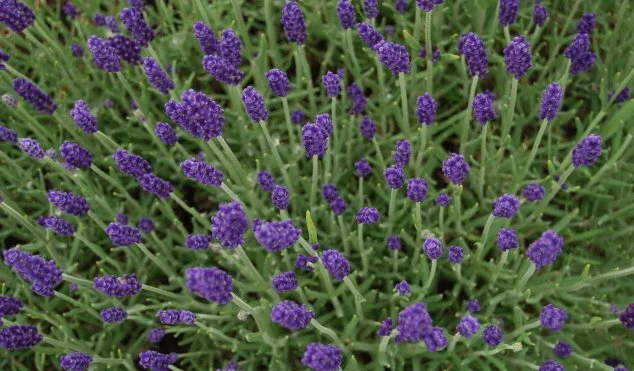All About Lavender
Lavender’s many unique properties have long been recognized and praised. It is indigenous to the Mediterranean region ranging from the Balkans in the east to Spain in the west. The Latin or botanical name of lavender is Lavandula derived from lave or to bathe. Its many early uses relied on its fresh aroma in perfumes and unguents. The dried buds strewn on stone floors scented the castles in Elizabethan times and laundry laid to dry on blooming plants freshened Victorian homes. In the Bible it is referred to as spike and it is reputed to have been used by Mary Magdalene in washing the feet of Jesus as well as by Cleopatra to woo Caesars. In more recent times lavender has been a popular garden plant throughout Europe and North America, prized for its rich color and heady scent.
An Example of an Intermedia Hybrid
The genus Lavandula has over ten varieties but only a few are readily available in nurseries and garden centers. The two most popular varieties are English lavender (Lavandula angustifolia) and a hybrid variety (Lavandula X intermedia) (a natural cross between L. angustifolia and L. latifolia) often referred to as intermedia or lavandin. Both of these varieties have at least a hundred named cultivars which sport many spike colors ranging from deep intense purple, bright blue to pale pink or white. Foliage color can vary from green to gray-green or even silver. Both of these varieties are generally hardy to Zone 5. English lavenders are typically characterized by a tight compact structure about 20’’ high when in bloom with a bloom stem of 6-8 inches and flower spikes of 1 ½ - 2 inches long. The flower aromas suggest a sweet, floral nature. On the other hand the intermedia lavenders are much taller and larger overall with bloom stems averaging over 18 inches and sometimes as long as 24’’. Flower spikes can be as long as 3 ½ - 4 inches that impart a more herbal aroma.
A third common lavender variety L. stoechas referred to as Spanish lavender has a strong pungent aroma but is attractive for its leaf-like petals (bracts) at the top of the spike that suggest rabbit ears or a roosting butterfly. One can’t help but smile when seeing these spikes move in a breeze. The Spanish lavender spike is cylindrical, wrapped with very tiny flowers. Foliage, flower and bract color show great variety among cultivars. Spikes can even be bi-color with a white bract atop a pale green cylinder with dark purple flowers. Spanish lavenders are hardy to Zone 7.
An Example of an English Lavender
All lavender cultivars are propagated by stem cuttings since English and Spanish lavenders are not true to seed and the intermedia lavenders are sterile. One must realize that growing English and Spanish lavender from seed will create a lot of variation in the final plants. Baby English or Spanish lavenders appearing beside the parent plant could look very different. But this is sometimes how new cultivars are selected and named! New intermedias are developed by choosing a specific English cultivar and crossing it with the L. latifolia. Lavenders have few growing requirements. Recall lavender’s native habitat. Plants do best grown with full sun in well-drained soil (loam or sandy loam) with a low humidity in the summer. Adding lime to an acidic soil at planting is helpful with only a little fertilizer. When planting small 4” starts, don’t let the root mass completely dry out the first summer. Sacrifice any blooms the first summer and let your plant establish strong roots instead. After the roots are established by the second summer only the hottest, arid areas will need supplemental water. By the third summer the plant should be fully drought tolerant. Pruning the plant in late summer by a third to a half being careful to leave some green leaves on each stem will keep your plants compact and provide vigorous bloom the following season. This practice has two major benefits: (1) Less wood in the plant means more plant energy for blooms and (2) the higher the woody material develops in the plant the more likely the plant will be damaged by winter rains and snow and thus break apart and lose vigor (i.e. short life). When properly cared for lavender in the home garden (with no additional fertilizer after planting) can easily last 10 to 12 years and longer.


